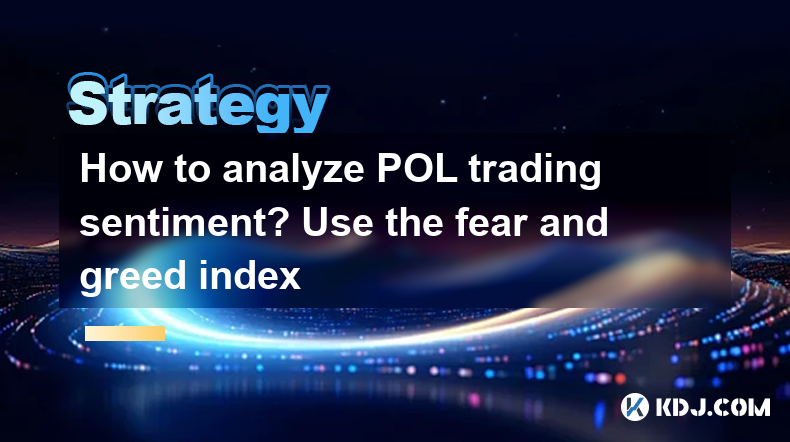-
 bitcoin
bitcoin $110918.433029 USD
-1.69% -
 ethereum
ethereum $3996.872473 USD
-2.43% -
 tether
tether $1.000594 USD
0.00% -
 bnb
bnb $1178.871834 USD
-2.38% -
 xrp
xrp $2.413973 USD
-3.47% -
 solana
solana $194.341461 USD
-4.24% -
 usd-coin
usd-coin $0.999963 USD
-0.03% -
 tron
tron $0.320092 USD
0.92% -
 dogecoin
dogecoin $0.196919 USD
-3.42% -
 cardano
cardano $0.669585 USD
-3.63% -
 hyperliquid
hyperliquid $37.485952 USD
-3.58% -
 ethena-usde
ethena-usde $1.000026 USD
-0.02% -
 chainlink
chainlink $18.018220 USD
-5.13% -
 bitcoin-cash
bitcoin-cash $523.879267 USD
-2.41% -
 stellar
stellar $0.324655 USD
-3.67%
How to analyze POL trading sentiment? Use the fear and greed index
Analyzing POL trading sentiment with the Fear and Greed Index helps traders gauge market emotions, informing decisions on entry/exit points and risk management.
May 02, 2025 at 01:21 am

Analyzing the trading sentiment of Polygon (POL) using the Fear and Greed Index can provide valuable insights into the market's emotional state and help traders make informed decisions. The Fear and Greed Index is a tool that measures the emotions and sentiments of investors in the cryptocurrency market. By understanding how to interpret this index and apply it specifically to POL, traders can better navigate the volatile crypto market.
Understanding the Fear and Greed Index
The Fear and Greed Index is a composite indicator that combines several market factors to gauge the overall sentiment of the cryptocurrency market. It ranges from 0 to 100, where a value closer to 0 indicates extreme fear, and a value closer to 100 indicates extreme greed. The index is calculated using various metrics, including market volatility, trading volume, social media sentiment, and more.
To analyze POL trading sentiment using the Fear and Greed Index, it's crucial to understand the components that contribute to the index and how they relate to POL's market performance. For instance, if the index shows high levels of greed, it might suggest that investors are overly optimistic about POL, potentially indicating a market top. Conversely, high levels of fear might suggest a buying opportunity if POL's fundamentals remain strong.
Gathering Data for POL
To begin analyzing POL trading sentiment, traders need to gather relevant data. This includes:
- Current POL price and trading volume: These metrics provide insights into the immediate market conditions and can be found on various cryptocurrency exchanges and market analysis platforms.
- Fear and Greed Index values: These can be obtained from websites that track the index, such as Alternative.me or CNN Money.
- Social media sentiment: Platforms like Twitter and Reddit can offer real-time insights into what the community is saying about POL.
- Market volatility: This can be measured using tools like the Bollinger Bands or the Average True Range (ATR) to understand how volatile POL's price movements are.
Once these data points are collected, traders can start to piece together a comprehensive picture of the current sentiment surrounding POL.
Interpreting the Fear and Greed Index for POL
Interpreting the Fear and Greed Index in the context of POL involves understanding how the index's value aligns with POL's price movements and market conditions. Here are some steps to consider:
- Compare the Index to POL's Price: If the Fear and Greed Index is high (indicating greed) and POL's price is also rising, it might suggest that the market is overbought. Conversely, if the index is low (indicating fear) and POL's price is falling, it might indicate an oversold market.
- Analyze Historical Data: Look at historical Fear and Greed Index values and POL's price movements to identify patterns. For instance, if POL's price tends to bottom out when the index is at extreme fear levels, this could be a signal to buy.
- Consider Other Market Factors: The Fear and Greed Index should not be used in isolation. Factors like regulatory news, technological developments, and overall market trends should also be considered when analyzing POL's trading sentiment.
Using the Fear and Greed Index in Trading Decisions
Traders can use the Fear and Greed Index to inform their trading decisions for POL. Here's how:
- Entry and Exit Points: If the Fear and Greed Index indicates extreme fear, and POL's price is at a low point, it might be a good time to enter a long position. Conversely, if the index shows extreme greed and POL's price is at a high, it might be time to exit or take profits.
- Risk Management: The index can help traders adjust their risk levels. For instance, during periods of extreme greed, traders might reduce their position sizes to mitigate potential losses if the market turns.
- Contrarian Trading: Some traders use the Fear and Greed Index to take contrarian positions. If the index shows extreme greed, they might short POL, expecting a market correction. If it shows extreme fear, they might go long, anticipating a rebound.
Tools and Platforms for Analysis
Several tools and platforms can help traders analyze POL's trading sentiment using the Fear and Greed Index. Some popular options include:
- TradingView: This platform offers advanced charting tools and indicators that can be customized to include the Fear and Greed Index. Traders can overlay the index on POL's price chart to see correlations and trends.
- CoinGecko: This website provides detailed market data for POL, including trading volume and social media sentiment, which can be combined with the Fear and Greed Index for a holistic analysis.
- CryptoQuant: This platform offers on-chain and market data that can be used alongside the Fear and Greed Index to gain deeper insights into POL's market sentiment.
Practical Application: A Case Study
To illustrate how to analyze POL trading sentiment using the Fear and Greed Index, consider the following case study:
- Scenario: The Fear and Greed Index is currently at 75, indicating greed. POL's price has been steadily rising over the past week, and trading volume is high.
- Analysis: The high Fear and Greed Index value suggests that the market might be overbought. Traders should be cautious about entering new long positions at these levels.
- Action: A trader might decide to take profits on existing POL positions or wait for a dip in the Fear and Greed Index before entering new trades. If the index drops to a more neutral level (e.g., 50), and POL's price also corrects, it could present a better entry point.
Frequently Asked Questions
Q: Can the Fear and Greed Index be used for other cryptocurrencies besides POL?A: Yes, the Fear and Greed Index can be applied to any cryptocurrency. The principles of interpreting the index remain the same, but traders should consider the specific market dynamics and fundamentals of each cryptocurrency.
Q: How often should I check the Fear and Greed Index when trading POL?A: The frequency of checking the Fear and Greed Index depends on your trading strategy. For short-term traders, checking the index daily or even multiple times a day might be beneficial. Long-term investors might check it weekly or monthly to gauge overall market sentiment.
Q: Are there any limitations to using the Fear and Greed Index for POL trading sentiment analysis?A: Yes, the Fear and Greed Index is just one tool among many. It should not be used in isolation, as it does not account for all market factors. Additionally, the index can be influenced by short-term market movements and might not always accurately reflect long-term trends.
Q: How can I combine the Fear and Greed Index with technical analysis for POL trading?A: Combining the Fear and Greed Index with technical analysis involves using the index as a sentiment indicator alongside technical indicators like moving averages, RSI, and MACD. For instance, if the Fear and Greed Index indicates extreme fear and the RSI shows POL as oversold, it might be a strong signal to buy.
Disclaimer:info@kdj.com
The information provided is not trading advice. kdj.com does not assume any responsibility for any investments made based on the information provided in this article. Cryptocurrencies are highly volatile and it is highly recommended that you invest with caution after thorough research!
If you believe that the content used on this website infringes your copyright, please contact us immediately (info@kdj.com) and we will delete it promptly.
- Larry Fink and BlackRock: Tokenizing All the Assets, Baby!
- 2025-10-16 11:05:12
- Meme Coin Mania: MoonBull, FLOKI, and SHIB – What's the Buzz?
- 2025-10-16 09:10:00
- Pepeto's Presale Success: Riding the Crypto Bull Run Wave
- 2025-10-16 08:30:01
- Affordable GPUs for Gamers: A 2025 Deep Dive
- 2025-10-16 10:25:12
- Coinbase, BNB, and Token Listings: A New Era?
- 2025-10-16 09:25:16
- Secure Enclave, Flow, and Launch: What's the Buzz?
- 2025-10-16 08:30:01
Related knowledge

Practical parameter settings for a Bitcoin multi-timeframe moving average system
Sep 18,2025 at 10:54pm
Optimizing Timeframe Combinations for Bitcoin Trading1. Selecting appropriate timeframes is crucial when building a multi-timeframe moving average sys...

How can I filter out false breakouts in Dogecoin high-frequency trading?
Sep 22,2025 at 01:00am
Understanding False Breakouts in Dogecoin Trading1. A false breakout occurs when Dogecoin's price appears to move beyond a defined support or resistan...

Techniques for identifying tops and bottoms in the Bitcoin on-chain NVT model
Sep 20,2025 at 07:54pm
Understanding the NVT Model in Bitcoin Analysis1. The Network Value to Transactions (NVT) ratio is often described as the 'P/E ratio' of the cryptocur...

What does the surge in open interest in Bitcoincoin futures mean?
Sep 20,2025 at 11:18pm
Understanding the Surge in Dogecoin Futures Open Interest1. A surge in open interest within Dogecoin futures indicates a growing number of active cont...

How can I use the Ethereum USDT premium to gauge market sentiment?
Sep 18,2025 at 11:55pm
Understanding the Ethereum USDT Premium1. The Ethereum USDT premium refers to the price difference between USDT (Tether) traded on Ethereum-based plat...

What should I do if Ethereum staking yields decline?
Sep 20,2025 at 06:18am
Understanding the Causes Behind Declining Ethereum Staking Yields1. The Ethereum network transitioned to a proof-of-stake consensus mechanism with the...

Practical parameter settings for a Bitcoin multi-timeframe moving average system
Sep 18,2025 at 10:54pm
Optimizing Timeframe Combinations for Bitcoin Trading1. Selecting appropriate timeframes is crucial when building a multi-timeframe moving average sys...

How can I filter out false breakouts in Dogecoin high-frequency trading?
Sep 22,2025 at 01:00am
Understanding False Breakouts in Dogecoin Trading1. A false breakout occurs when Dogecoin's price appears to move beyond a defined support or resistan...

Techniques for identifying tops and bottoms in the Bitcoin on-chain NVT model
Sep 20,2025 at 07:54pm
Understanding the NVT Model in Bitcoin Analysis1. The Network Value to Transactions (NVT) ratio is often described as the 'P/E ratio' of the cryptocur...

What does the surge in open interest in Bitcoincoin futures mean?
Sep 20,2025 at 11:18pm
Understanding the Surge in Dogecoin Futures Open Interest1. A surge in open interest within Dogecoin futures indicates a growing number of active cont...

How can I use the Ethereum USDT premium to gauge market sentiment?
Sep 18,2025 at 11:55pm
Understanding the Ethereum USDT Premium1. The Ethereum USDT premium refers to the price difference between USDT (Tether) traded on Ethereum-based plat...

What should I do if Ethereum staking yields decline?
Sep 20,2025 at 06:18am
Understanding the Causes Behind Declining Ethereum Staking Yields1. The Ethereum network transitioned to a proof-of-stake consensus mechanism with the...
See all articles


























![Web3 Crypto Market Morning Report: The market is in decline, altcoins have fallen by more than 5%, Binance compensation has been received, and Memes on the Bnb chain have collectively plummeted [Vic TALK Issue 1444] Web3 Crypto Market Morning Report: The market is in decline, altcoins have fallen by more than 5%, Binance compensation has been received, and Memes on the Bnb chain have collectively plummeted [Vic TALK Issue 1444]](/uploads/2025/10/16/cryptocurrencies-news/videos/web-crypto-market-morning-report-market-decline-altcoins-fallen-binance-compensation-received-memes-bnb-chain-collectively-plummeted-vic-talk-issue/68f043c9c8b44_image_500_375.webp)















































